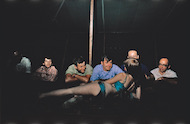“Carnival Strippers,” the 1976 book by Susan Meiselas, was a landmark in photographic publishing. Its black-and-white images of “exotic dancers” came with documentation of how these women viewed their work. Photography’s natural voyeurism seemed counterbalanced by genuine sensitivity. The project began Meiselas’s distinguished career as a photojournalist, producing celebrated images from war-torn Nicaragua, El Salvador and Kurdistan.
She recently discovered color slides she’d shot alongside her black-and-whites. Higher Pictures Generation is showing them for the first time in “Carnival Strippers Color, 1972-1975,” alongside the interview notes with her subjects.
The exhibition’s 14 color prints yield a “reality effect” absent from Meiselas’s black-and-whites. They bring us that much closer to these women and their garish surroundings in rural carnivals: red signage matches scarlet bras. That made me realize that the sensitivity in these pictures may come from psychic links between shooter and subjects: As a 20-something woman in the male-dominated world of 1970s photography — of ’70s America — Meiselas was facing the same issues of gender expectations and agency that the strippers discuss in their interviews. “I’m too bright to just sit around in the kitchen or just sit around and clean house,” said one performer named Lisa, who had done just that. She had “a splittin‘ thing,” and needed to take off and “do something that I wanted to do.”
Was “Carnival Strippers” Meiselas’s own means of “splittin‘” from expectations?
In “Shortie on Stage,” the four men ogling the dancer could easily stand for Meiselas’s male colleagues gawping as she dares to snap the shot.

